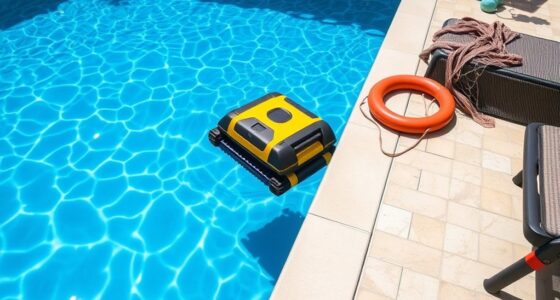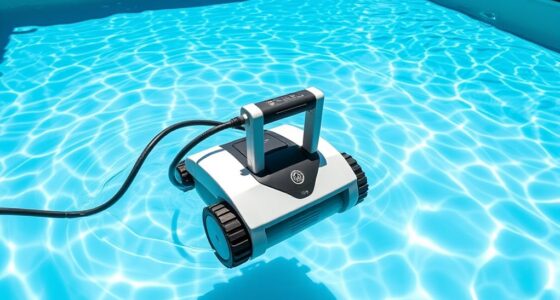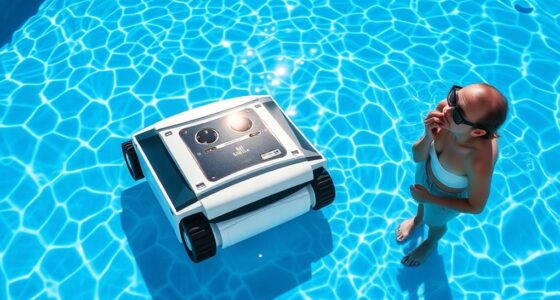Robotic pool cleaners work by using advanced navigation systems that map your pool and avoid obstacles, while specialized brushes scrub surfaces and vacuums debris into built-in filters. They run on rechargeable batteries and can be programmed or controlled via smartphone apps, allowing for scheduled cleanings. Their intelligent design guarantees thorough coverage with minimal effort from you. Keep exploring to discover how these smart devices make maintaining your pool easier and more efficient.
Key Takeaways
- Robotic pool cleaners use internal motors to generate water circulation and suction, directing debris toward their filtration systems.
- They are equipped with sensors that map the pool, detect obstacles, and optimize cleaning paths.
- Brushes or scrubbers loosen dirt from surfaces, rotating or sweeping as water flows through the device.
- Powered by rechargeable batteries, some models incorporate advanced navigation and user control via apps or displays.
- Effective filtration systems trap dirt, debris, and algae, maintaining water quality and ensuring thorough cleaning coverage.
Components and Design of Robotic Pool Cleaners

Robotic pool cleaners are designed with a combination of specialized components that work together to efficiently clean your pool. At the core is the filtration system, which traps dirt, debris, and algae as water flows through it, ensuring your pool stays clear. These cleaners rely on water circulation to move around the pool, powered by internal motors or pumps that generate suction. The water flow pulls leaves and particles into the filtration system, preventing them from settling on the pool floor or walls. The design typically includes brushes or scrubbers that help loosen dirt, making the filtration process more effective. By combining these components, robotic pool cleaners deliver thorough cleaning while operating independently, saving you time and effort. Proper maintenance of these parts can extend the lifespan and efficiency of your cleaner materials used, and regular inspection of internal motors or pumps ensures optimal performance and longevity. Additionally, understanding pool cleaning technology can help you select the best model for your needs and maintain it properly. Advances in automation technology continue to improve the capabilities and efficiency of robotic pool cleaners.
Navigation Systems and Path Planning

How do robotic pool cleaners know where to go and what areas to clean? They rely on sophisticated navigation systems that use sensor calibration to map the pool and detect obstacles. These sensors help the cleaner understand water flow, depth, and boundaries, ensuring thorough coverage. Path planning algorithms allow the robot to optimize cleaning routes, avoiding redundant passes. Some models use random patterns, while others follow systematic grids for efficiency. Water filtration systems are integrated into navigation to monitor water quality and avoid areas with debris or algae. To maximize performance, regular sensor calibration is essential for accurate navigation. Additionally, understanding the affairs within the system’s operation can help maintain optimal function and longevity. Regular maintenance and understanding the different cookie types can also contribute to optimal operation. Here’s a quick comparison:
| Feature | Function |
|---|---|
| Sensor Calibration | Ensures precise obstacle detection and mapping |
| Water Filtration | Keeps water clean and helps avoid debris buildup |
Cleaning Mechanisms and Brushes
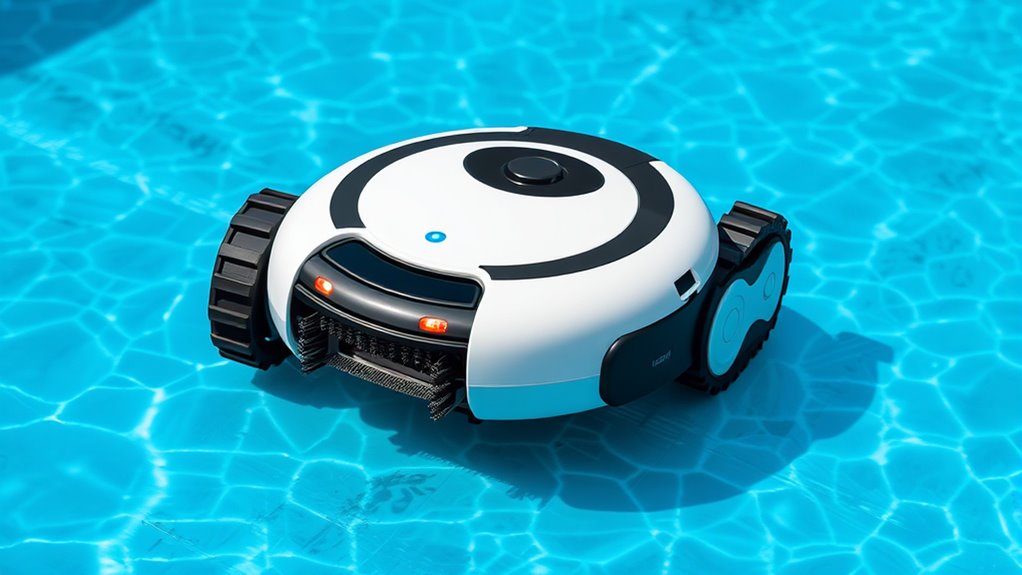
Cleaning mechanisms and brushes are essential for ensuring your pool stays spotless. They work together to scrub surfaces and collect debris efficiently. Most robotic cleaners use brush types such as rotary, rubber, or microfiber brushes, each designed to loosen dirt and algae from pool surfaces. These brushes rotate or sweep as water circulates through the cleaner, helping to lift dirt from walls and floors. The water circulation inside the robot directs debris toward the filter, preventing clogs and ensuring continuous cleaning. Proper water circulation enhances the cleaning process, allowing brushes to reach all surfaces thoroughly and keeping your pool crystal clear. Additionally, the integration of advanced navigation systems allows robotic pool cleaners to cover the entire pool area more effectively, reducing missed spots and improving overall cleaning efficiency. Developing a growth mindset can also improve your understanding of how these mechanisms work, leading to better maintenance and troubleshooting. Additionally, advancements in robotic technology continue to improve the efficiency and effectiveness of pool cleaners.
Power Source and Battery Technology
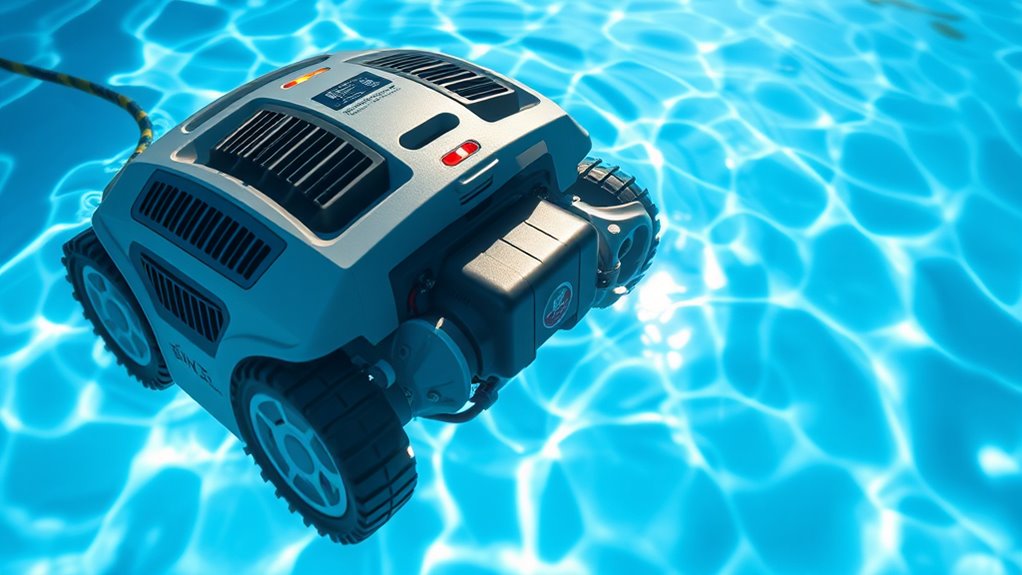
Have you ever wondered what powers a robotic pool cleaner? Many models use rechargeable batteries, with lithium-ion batteries being the most common due to their long battery lifespan. These batteries store energy that keeps the cleaner moving and functioning efficiently. Some advanced models even incorporate solar power technology, allowing them to harness sunlight to recharge, reducing reliance on traditional charging methods. This solar power technology not only helps in conserving energy but also minimizes the environmental impact of pool maintenance. This eco-friendly feature extends battery lifespan by minimizing charge cycles and conserving energy. When choosing a robotic pool cleaner, consider how the power source affects runtime and maintenance. A longer battery lifespan means fewer replacements and less downtime, ensuring your cleaner works smoothly for seasons. Whether powered by traditional batteries or solar energy, these innovations keep your pool spotless with minimal effort. Additionally, advancements in battery technology have led to faster charging times and increased durability, enhancing overall performance and convenience.
Programming and Control Features

Modern robotic pool cleaners come equipped with advanced programming and control features that make maintenance effortless. You can set cleaning schedules, customize cleaning modes, and even target specific areas using intuitive controls. Sensor integration plays a key role, allowing the robot to detect obstacles, identify pool walls, and adapt its cleaning path accordingly. This adaptive navigation enhances cleaning efficiency and reduces the need for manual intervention. This ensures thorough coverage without missing spots or wasting energy. The user interface, often accessible via a smartphone app or a simple onboard display, makes programming straightforward. You can monitor cleaning progress, adjust settings on the fly, and receive alerts when maintenance is needed. Incorporating advanced technology features in marketing materials can also highlight the innovative capabilities of these cleaners, boosting consumer confidence. Additionally, engineered components like smart sensors and adaptive algorithms further optimize the cleaning process, making robotic pool cleaners more effective and user-friendly. For optimal performance, understanding programming options can help users customize their cleaning routines more efficiently.
Advantages Over Traditional Pool Cleaning Methods

Robotic pool cleaners offer significant advantages over traditional methods like manual skimming or using hoses. They provide consistent cleaning, reducing the risk of missed spots and debris buildup. This helps maintain better pool water chemistry by preventing algae growth and bacteria, promoting healthier swimming conditions. You can also experience automatic operation that minimizes your direct involvement, freeing up your time for other activities. With robotic cleaners, you can improve pool safety by minimizing the need for risky manual scrubbing or chemical imbalance caused by uneven cleaning. These devices operate independently, saving you time and effort while ensuring thorough debris removal from floors and walls. Additionally, robotic cleaners often include filters that trap fine particles, supporting ideal water quality. Vetted – Appliances Labs also highlights the importance of choosing models with effective filtration systems for optimal performance. Selecting a model with advanced navigation can ensure comprehensive coverage of your pool surfaces. Implementing efficient cleaning patterns can further enhance the overall effectiveness of the robotic cleaner. Incorporating technological innovation can lead to even smarter cleaning solutions that adapt to your pool’s unique layout. Overall, they make maintaining a clean, safe, and balanced pool easier, giving you peace of mind and more swimming time.
Frequently Asked Questions
How Long Do Robotic Pool Cleaners Typically Operate Before Needing a Recharge?
Robotic pool cleaners usually operate for about 1.5 to 2 hours before needing a recharge. Your device’s battery life determines how long it can clean efficiently, and charging time typically takes around 3 to 4 hours. You should plan to recharge it fully between sessions to guarantee peak performance. Keep an eye on the battery indicator, so you know when it’s time to plug it in and get it ready for the next cleaning.
Are Robotic Pool Cleaners Suitable for All Pool Types and Sizes?
Imagine your pool shimmering clean, no matter its size or shape. Robotic pool cleaners are versatile, designed to handle various pool sizes and shapes efficiently. They navigate corners, sweep along walls, and cover every inch with ease. Whether your pool is small and round or large and irregular, these cleaners adapt, ensuring thorough cleaning without manual effort. You get a sparkling pool, hassle-free, tailored to your unique swimming space.
What Maintenance Is Required to Keep a Robotic Pool Cleaner Functioning Properly?
To keep your robotic pool cleaner working well, you need to perform regular filter maintenance by cleaning or replacing the filter as needed. Additionally, check for software updates from the manufacturer to guarantee peak performance and fix any bugs. Keep an eye on brushes and wheels for debris or wear, and store the cleaner in a dry place when not in use. These steps help extend your device’s lifespan.
Can Robotic Pool Cleaners Remove Algae and Bacteria Effectively?
Robotic pool cleaners are effective at algae removal and bacteria control when used regularly. They scrub surfaces thoroughly, removing algae buildup and preventing bacteria growth. While they excel at surface cleaning, you should still maintain proper water chemistry and run additional treatments like chlorine or algaecides for ideal sanitation. Using a robotic cleaner consistently keeps your pool cleaner, healthier, and reduces the need for harsh chemicals.
How Do Robotic Pool Cleaners Handle Obstacles Like Ladders or Drains?
Obstacle navigation in robotic pool cleaners is so advanced, it’s like they have a sixth sense. They detect surfaces and obstacles, such as ladders or drains, using sensors that enable precise surface detection. When they encounter an obstacle, they automatically change direction or adjust their path to avoid it, ensuring thorough cleaning without getting stuck. This smart navigation keeps your pool spotless, no matter how tricky the obstacles may be.
Conclusion
Now that you understand how robotic pool cleaners work, picture them as your underwater helpers, seamlessly gliding across your pool like silent swimmers. While traditional methods rely on hoses and manual effort, these machines harness advanced technology to effortlessly keep your pool sparkling. As they navigate and scrub with precision, you can sit back and enjoy your clean, inviting oasis—free from the chaos of cords and buckets, replaced by sleek, intelligent efficiency.


